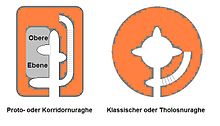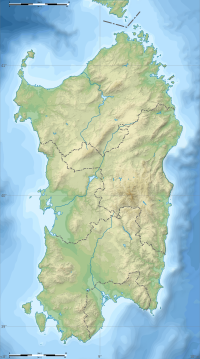Protonuraghe
Protonuraghen (also corridor or pseudonuraghen, Italian Nuraghe a corridoio ) are the pre- or early form of the classical tower structures or Tholosnuraghen ( Italian Nuraghe a tholos ) of the Bronze Age nuragic cultures in Sardinia . The age of the protonuraghi has long been debated. Giovanni Lilliu , one of the most famous Sardinian archaeologists , initially considered them to be late, degenerate forms of the actual nuragic towers . Initial excavations seemed to support this. Lilliu quoted Pausanias who saw the Roman attack of 231 BC. BC described and mentions that the indigenous people of Sardinia carried out their attacks from underground structures and caves. Protonuraghen seemed to correspond to this description, as they were often built using rocks (especially visible in the Protonuraghe Albucciu ). However, Ercole Contu, who led the excavation of the Protonuraghe Peppe Gallu , could prove the opposite. After the excavation of the Protonuraghe Brunku Madagui (surrounded by a late Nuragic settlement) it is clear that Protonuraghe are among the early constructions and can be dated to the Early Bronze Age. However, there is evidence that some of them were used well into the Iron Age and even as late as the Colonial Period.
to form
Among the protonuraghi there are only a few that have round chambers ( Izzana in Aggius and Serra Castrula), which are obligatory for the later nuraghi . Incidentally, there are two cultures that they established in four basic forms:
1. Corridor Uraghen; Sometimes a corridor covered with horizontal slabs ( lintel ) or with a cantilever vault completely crosses the building, creating a double-sided entrance. There are simple corridor constructions, as shown in the Nuraghe Urzeghe, and complex ones in the Protonuraghen Tusari (with five niches and a staircase), and those similar to the Corsican Torren , based on natural rock outcrops ( Albucciu near Arzachena and Arrubiu near Quirra ).
2. Protonuraghen with a ship-shaped interior; a later development of the protonuraghen represents a type whose corridor becomes wider and higher after a narrow and low lintel-covered piece. The ceiling has the shape of a donkey's back or an upturned ship ( Protonuraghe Orgono ).
3. The most common is the type with a blind-ended corridor, where there are small side niches or cross corridors that may intersect. U. open to a staircase that led to the upper part of the structure. In other cases, short transverse corridors opened up towards the corridor with small rooms at the ends covered with cantilever vaults . These are the harbingers of the Tholosnuraghen. The transition to the nuraghi with vaults seems to be represented by the nuraghi Albucciu, near Arzachena , Izzana and Su Mulinu , near Villanovafranca, in which both ceiling forms can be found.
4. In some cases ( Friarosu , near Mogorella ) there are no corridors in the wall, but only small cells that can be reached from the outside.
The outline of protonuraghi can be round, oval, D-shaped, trapezoidal, rectangular or irregular ( Nuraghe Brunku Madagui ). Inside the squat buildings, besides corridors and niches, there is sometimes a so-called guard cell near the entrance (e.g. Front'e Mola near Thiesi ). Some of the forms, which are only up to 10 m high but cover areas of up to 250 m², have two levels or have a roof platform. In these structures, which are characterized by considerable wall mass, of which only a small part was used through a few narrow spaces, the platform of the upper terrace was the functional part.
Protonuraghi may have continued to be used after the architecture of the more than 25 times more common tholosnuraghi became established.
Tholosnuraghen
The Tholosnuraghen are always round, much higher (up to 20 m), but cover a smaller area (about 100 m²). Their characteristic is the central, round chamber, rarely without, more often with two to four niches; but mostly with three - like the nuraghe sketched. This means that their internal construction (especially with regard to the dome shape) roughly corresponds to the Irish-Scottish megalithic systems of the Newgrange and Maes Howe types , while the floor plan corresponds to that of the Scottish Brochs .
Time position
The approximately 300 Protonuraghi on Sardinia were formed during phase B of the two-phase Bonnanaro culture , which was the successor to the both megalithic and Copper Age Monte Claro culture between 1800 and 1500 BC. Ruled.
List of protonuraghen with article
Protonuraghi in Sardinia |
- Albucciu , Arzachena (OT)
- Brunku Madagui , Gesturi (MC)
- Corongiu Maria , Nurri (CA)
- Friarosu , Mogorella (OR)
- Front'e Mola , Thiesi (SS)
- Izzana , Tempio Pausania (SS)
- Orgono , Ghilarza (OR)
- Sa Fogaia , Siddi (MC)
- Seneghe , Suni (OR)
- Peppe Gallu , Uri (SS)
See also
literature
- Paolo Melis: Nuragic culture Carlo Delfino editore, Sassari 2003, ISBN 88-7138-276-5 .

